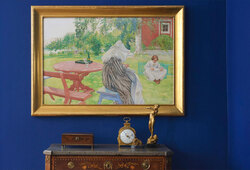Carl Malmsten
CARL MALMSTEN, a cabinet "Ljus och Mörker" (The Light and The Dark), Sweden 1974.
Mahogany, inlays in different kinds of wood, the upper part with an interior of mahogany with shelves and three drawers, the lower part with shelves. Marked CM to the 44back. 178 x 106, depth 43,5 cm. Key included.
One side faded and with water stains, the back with drilled hole.
Muut tiedot
CITES certificate, valid within the EU included.
Prospective purchasers are advised that several countries prohibit the importation of property containing materials from endangered species, including but not limited to coral, ivory, tortoiseshell and palisander.
Accordingly, prospective purchasers should familiarize themselves with relevant customs regulations prior to
bidding if they intend to import this lot into another country.
Suunnittelijat
Carl Malmsten is one of Sweden's most famous furniture designers. Many of his furniture are considered modern design classics, for example, the cane chair "Lilla Åland", the armchair "Farmor", the sofa "Samsas", the cabinet "Herrgården", and the furniture series "Vardag".
Both "Lilla Åland" and "Vardag" adopted the ideals of "beautiful everyday goods" of the 1940s. Their neat shape and frugal design quickly became timeless interior details that we still see in many homes today.
At the beginning of his career, Malmsten interned at various carpentry workshops and studied furniture at Nordiska museet and Skansen. He had his breakthrough in 1916 when he was commissioned to design part of the interior of Stockholm's City Hall.
During his career, Malmsten collaborated with several architects, such as Ragnar Östberg, Ivar Tengbom, and Ferdinand Boberg. He designed furniture for Stockholm's concert hall and Ulriksdal castle. He participated in the now iconic hosing exhibition at Liljevalchs gallery in 1917, where the term "Beautiful everyday goods" was coined.






















































